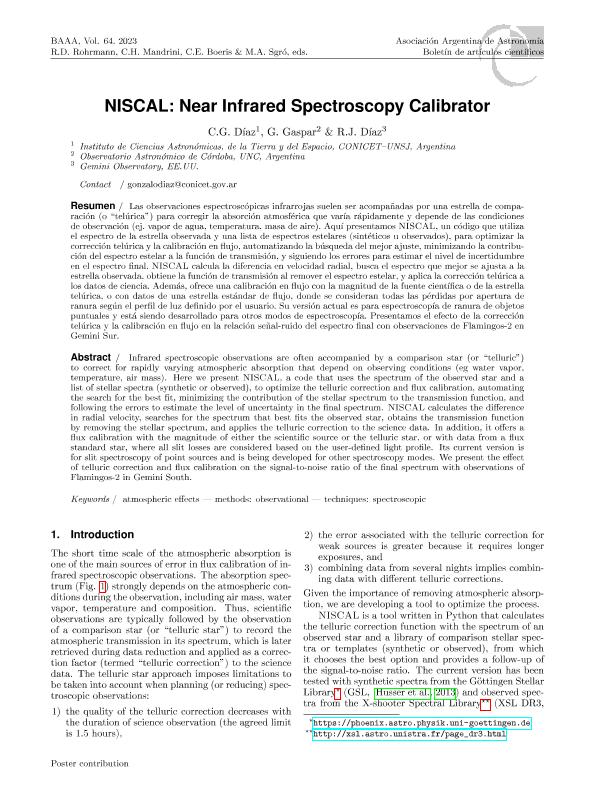Mostrar el registro sencillo del ítem
dc.contributor.author
Diaz, Carlos Gonzalo

dc.contributor.author
Gaspar, G.
dc.contributor.author
Diaz, R. J.
dc.date.available
2024-01-05T10:39:46Z
dc.date.issued
2023-08
dc.identifier.citation
Diaz, Carlos Gonzalo; Gaspar, G.; Diaz, R. J.; NISCAL: Near Infrared Spectroscopy Calibrator; Asociación Argentina de Astronomía; Boletín de la Asociación Argentina de Astronomía; 64; 8-2023; 329-331
dc.identifier.issn
0571-3285
dc.identifier.uri
http://hdl.handle.net/11336/222483
dc.description.abstract
Infrared spectroscopic observations are often accompanied by a comparison star (or “telluric”) to correct for rapidly varying atmospheric absorption that depend on observing conditions (eg. water vapor, temperature, air mass). Here we present NISCAL, a code that uses the spectrum of the observed star and a list of stellar spectra (synthetic or observed), to optimize the telluric correction and flux calibration, automating the search for the best fit, minimizing the contribution of the stellar spectrum to the transmission function, and following the errors to estimate the level of uncertainty in the final spectrum. NISCAL calculates the difference in radial velocity, searches for the spectrum that best fits the observed star, obtains the transmission function by removing the stellar spectrum, and applies the telluric correction to the science data. In addition, it offers a flux calibration with the magnitude of either the scientific source or the telluric star, or with data from a flux standard star, where all slit losses are considered based on the user-defined light profile. Its current version is for slit spectroscopy of point sources and is being developed for other spectroscopy modes. We present the effect of telluric correction and flux calibration on the signal-to-noise ratio of the final spectrum with observations of Flamingos-2 in Gemini South.
dc.description.abstract
Las observaciones espectroscópicas infrarrojas suelen ir acompañadas de una estrella de comparación (o "telúrica") para corregir la absorción atmosférica que varía rápidamente y depende de las condiciones de observación (por ejemplo, vapor de agua, temperatura, masa de aire). Aquí presentamos NISCAL, un código que utiliza el espectro de la estrella observada y una lista de espectros estelares (sintéticos u observados), para optimizar la corrección telúrica y la calibración del flujo, automatizando la búsqueda del mejor ajuste, minimizando el aporte de la estrella observada. espectro a la función de transmisión, y siguiendo los errores para estimar el nivel de incertidumbre en el espectro final. NISCAL calcula la diferencia de velocidad radial, busca el espectro que mejor se ajusta a la estrella observada, obtiene la función de transmisión eliminando el espectro estelar y aplica la corrección telúrica a los datos científicos. Además, ofrece una calibración de flujo con la magnitud de la fuente científica o de la estrella telúrica, o con datos de una estrella de flujo estándar, donde todas las pérdidas por rendija se consideran en función del perfil de luz definido por el usuario. Su versión actual es para espectroscopia de rendija de fuentes puntuales y se está desarrollando para otros modos de espectroscopia. Presentamos el efecto de la corrección telúrica y la calibración de flujo en la relación señal-ruido del espectro final con observaciones de Flamingos-2 en Gemini Sur.
dc.format
application/pdf
dc.language.iso
eng
dc.publisher
Asociación Argentina de Astronomía
dc.rights
info:eu-repo/semantics/openAccess
dc.rights.uri
https://creativecommons.org/licenses/by-nc-sa/2.5/ar/
dc.subject
ATMOSPHERIC EFFECTS
dc.subject
METHODS: OBSERVATIONAL
dc.subject
TECHNIQUES: SPECTROSCOPIC
dc.subject.classification
Astronomía

dc.subject.classification
Ciencias Físicas

dc.subject.classification
CIENCIAS NATURALES Y EXACTAS

dc.title
NISCAL: Near Infrared Spectroscopy Calibrator
dc.type
info:eu-repo/semantics/article
dc.type
info:ar-repo/semantics/artículo
dc.type
info:eu-repo/semantics/publishedVersion
dc.date.updated
2024-01-03T12:15:42Z
dc.identifier.eissn
1669-9521
dc.journal.volume
64
dc.journal.pagination
329-331
dc.journal.pais
Argentina

dc.journal.ciudad
Capital
dc.description.fil
Fil: Diaz, Carlos Gonzalo. Consejo Nacional de Investigaciones Científicas y Técnicas. Centro Científico Tecnológico Conicet - San Juan. Instituto de Ciencias Astronómicas, de la Tierra y del Espacio. Universidad Nacional de San Juan. Instituto de Ciencias Astronómicas, de la Tierra y del Espacio; Argentina
dc.description.fil
Fil: Gaspar, G.. Universidad Nacional de Córdoba. Observatorio Astronómico de Córdoba; Argentina
dc.description.fil
Fil: Diaz, R. J.. Gemini Observatory; Estados Unidos
dc.journal.title
Boletín de la Asociación Argentina de Astronomía
dc.relation.alternativeid
info:eu-repo/semantics/altIdentifier/url/https://ui.adsabs.harvard.edu/abs/2023BAAA...64..329D/abstract
Archivos asociados
